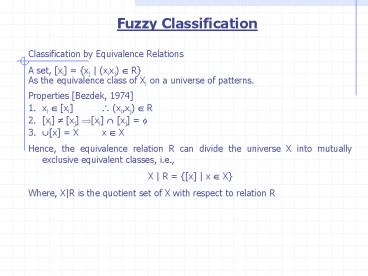Fuzzy Classification - PowerPoint PPT Presentation
1 / 19
Title:
Fuzzy Classification
Description:
Properties [Bezdek, 1974] xi [xi] (xi,xj) R [xi] [xj] [xi] [xj] ... With these classes, we can prove the three properties discussed earlier. ... – PowerPoint PPT presentation
Number of Views:2231
Avg rating:3.0/5.0
Title: Fuzzy Classification
1
Fuzzy Classification
- Classification by Equivalence Relations
- A set, xi xj (xixj) ? R
- As the equivalence class of Xi on a universe of
patterns. - Properties Bezdek, 1974
- xi ? xi ? (xi,xj) ? R
- xi ? xj ?xi ? xj ?
- ?x X x ? X
- Hence, the equivalence relation R can divide the
universe X into mutually exclusive equivalent
classes, i.e., - X R x x ? X
- Where, XR is the quotient set of X with respect
to relation R
2
Fuzzy Classification
R
The relation is reflexive, symmetric and
transitive. Hence, the matrix is an equivalence
relation.
3
Fuzzy Classification
We can group the elements of the universe into
classes as 1 4 7 10
1,4,7,10 with remainder 1 2 5
8 2,5,8 with remainder 2 3
6 9 3,6,9 with remainder 0 With
these classes, we can prove the three properties
discussed earlier. Hence, the quotient set is X
R (1,4,7,10),(2,5,8),(3,6,9) Not all
relations are equivalent, but a tolerance
relation can become an equivalent one by max-min
compositions.
4
Fuzzy Relations
Rt
? R
By taking ?-cuts of fuzzy equivalent relation R
at values of ? 1, 0.9, 0.8, 0.5, 0.4 we get
the following
R1
R0.9 R0.8
R0.5 R0.4
5
Fuzzy Relations
The classification can be described as follows
6
Fuzzy Relations
Example 3 families, 16 people related by blood.
Each has a photo, and find the relation by
viewing the photos. Similarity matrix is as
follows
7
Fuzzy Relations
Convert to an equivalent relation by composition.
8
Fuzzy Relations
?-cut ? 0.6, we have
9
Fuzzy Relations
Four distinct classes are identified 1,6,8,13,16
, 2,5,7,11,14, 3, 4,9,10,12,15 From this
clustering it seems that only photograph number 3
cannot be identified with any of the families.
Perhaps a lower value of ? might assign
photograph 3 to one of the other three
classes. The other three clusters are all correct.
10
Cluster Analysis
How many clusters? C-means clustering Sample set
X x1,x2,,xn n points, each xi
xi1,xi2,,xim is an m-dimensional vector.
Minimize the distance in each cluster Maximize
the distance between clusters
11
Cluster Analysis
Hard C-means (HCM) Classify data in crisp
sense. Each data will be one and only one cluster.
12
Cluster Analysis
The objective function for the hard c-means
algorithm is known as a within-class sum of
squared errors approach using a Euclidian norm to
characterize distance. It is given by Where, U
partition matrix V vector of cluster
centers Dik Euclidian distance in m-dimensional
feature space between the kth data sample and ith
cluster center vi, given by
13
Fuzzy Pattern Recognition
Features Feature Extraction Partition of feature
space
14
Fuzzy Pattern Recognition
Multi-feature pattern recognition more
features Multi-dimensional pattern
recognition 1. Nearest neighbor classifier. 2.
Nearest center classifier. 3. Weighted
approaching degree.
15
Fuzzy Pattern Recognition
Nearest neighbor approach Sample Xi has m
features xi xi1,xi2,,xim X X1,X2,,Xn We
can use C-fuzzy partitions, then get c-hard
partitions If we have new singleton data X,
then x and xi in the same class
16
Fuzzy Pattern Recognition
Nearest Center Classifier First got c-clusters,
the center for each cluster vi and V
V1,V2,,Vc x is in cluster i
17
Syntactic recognition
Examples include image recognition, fingerprint
recognition, chromosome analysis, character
recognition, scene analysis, etc. Problem how
to deal with noise? Solution a few noteworthy of
them are Fu, 1982 The use of approximation The
use of transformational grammars The use of
similarity and error-correcting parsing The use
of stochastic grammars The use of fuzzy grammars
18
Syntactic recognition
Fuzzy Grammar and Application Primitives are
fuzzy, or productions are fuzzy, or both are
fuzzy A fuzzy language J ri I 1,2,,n, n
cardinality of P ?(ri) membership rule of the
production rule r ?J?0,1
19
Syntactic recognition
A string x ? L iff M of derivations lk the
length of the kth derivation chain r ith
production used in the kth derivation chain

